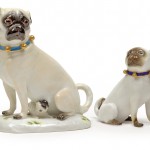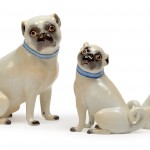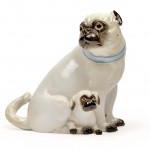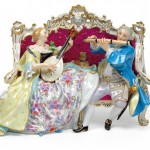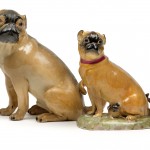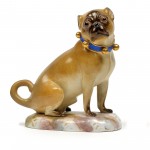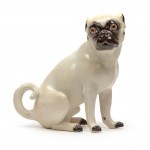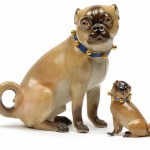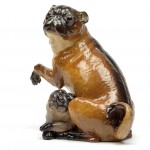From the Order of Freemasons to the Order of the Pug
A grand total of 15 porcelain pugs will feature in the glass and porcelain auction on Wednesday 20th April 2016. Founded within the context of the Enlightenment, the Freemasons’ order began in England and started to spread throughout Europe from 1715. Members of such orders pledged to lead their lives according to the ideals of freedom, equality, fraternity, tolerance, and humanity, and they derived their name from the stonemasons of mediaeval construction sites.
The first lodge in the German-speaking realm was founded in Hamburg in 1737 and it assumed the name “Absalom” in 1740. In 1740 Frederick the Great (1712-1786) prompted the establishment of the grand national mother lodge “The Three Globes” in Berlin and by 1754 there were 19 masonic lodges in Germany. In 1738 Pope Clemens XII (1652-1740) issued a papal bull which forbade masonic associations under penalty of excommunication.
The Order of the Pug
In 1740, Clemens August, Elector of Cologne (1700-1761) founded the Order of the Pug, a secret society of Freemasons. It was the first masonic order open to women, albeit only Catholics could undergo the initiation ritual. The pug gave its name to this order, as in courtly society it was a symbol for reliability, trust and steadfastness. The order’s insignia was a light blue collar with golden bells.
Members of the lodge called themselves “pugs” and wore, discreetly, a silver pug on a medallion.
In 1745 a so-called “traitor’s pamphlet” was published. This pamphlet revealed and publicized the rituals of the order and included engravings depicting the society’s initiation rites.
In 1748, the authorities of the University of Göttingen banned “Lodge Louise,” a student lodge of the Order of the Pug. This was to mark the permanent end of the order.
In 1751 Pope Benedict XIV further restricted Freemasonry in the papal bull “providas romanorum.”
Porcelain pugs
Johann Joachim Kändler created various porcelain pug models in the years 1740 to 1745.
In a logbook of his work, Kändler remarked that he had produced medium-sized pug figurines as pendants in August 1741 , probably for King August III (King of Poland, Elector of Saxony). First a female pug with a puppy and later a male pug.
One of the greatest lovers of pug figurines was August III’s prime minister, Count Heinrich von Brühl. His favourite figurine was modelled true to life in November 1742 by Johann Joachim Kändler and Johann Gottlieb Ehder, and the sculpture bore the monogram HGVB on a blue collar with a silver padlock.
Antiquities Auction
Wednesday 20th April 2016, 2pm
Glass and Porcelain in conjunction with the Sculpture and Antiquities Auction at ca. 4pm
Preview until 20th April 2016
Palais Dorotheum
Take a look at our Online Catalogue.

